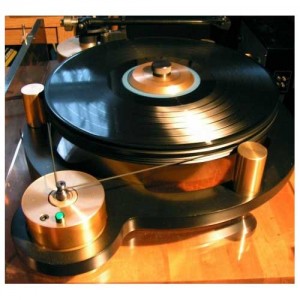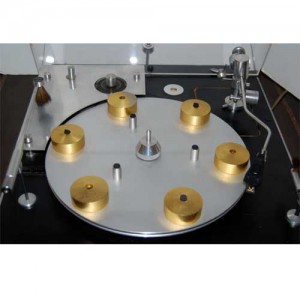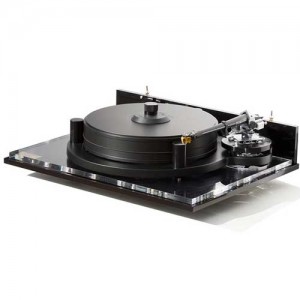John Michell began his engineering career when he served an apprenticeship with Finchley Autos in the early fifties. Deciding to start his own business, he set up in his garden shed and quickly moved to a small industrial unit in North London. Working as a jobbing engineering company, he soon outgrew the premises so, during the mid ‘60’s, moved to Borehamwood, which is where the company is still based today. Although very much an engineering company, John also made scale models and it was during this time that he met Stanley Kubrick and built the space ship ‘Discovery’ for the film 2001 – Space Odyssey, later to become the inspiration for the GyroDec
.
In the late 60’s, the company started to make parts for Transcriptors who subsequently re-located to the Michell premises. At this time, Michell were still supplying other local firms as well as working directly with the film studios making models and component parts for films such as Star Wars. When in 1973 Transcriptors re-located to Ireland, Michell took over the manufacturing under licence of the Hydraulic Reference turntable. These products are recognisable by their ‘By J.A. Michell Eng. Ltd’ name badges.
Mitchell "Transcriptor" Turntable from "A Clockwork Orange"
"-What Malcolm McDowell said as Alex in Stanley Kubricks "A Clockwork Orange" as he listened to Beethoven on a Mitchell turntable identical to this one. Designed in 1964 and completely hand made.
The original from the film is in the Museum Of Modern Art, in the permanent design collection. A striking object.
1977 saw the development of the first true Michell Engineering turntable – the Michell Reference Electronic. Offered in either a coloured mirror finish or marble plinth, both of these models are extremely rare these days. This was followed by the more upmarket Prisma, which was the first Michell product to be manufactured totally from the thick transparent acrylic material that was to become synonymous with all later Michell designs. Initially the LP record was supported by six pods only, as per the Reference, to reduce electrostatic charging of the vinyl. A later version of the Prisma added a glass platter on top, onto which the record was to be clamped.
Being such a personable company and always willing to satisfy where possible, it was at this time that Michell also started to make certain ‘special orders’ for customers and distributors. A rare example is the Double Prisma. Mainly sold on the German market, the deck featured two platters working from the same drive system. A total of four arms could also be fitted.
With sales growing steadily, it was decided to introduce an entry-level product so that the Michell brand could reach out to a wider audience. The Focus One consisted of a simple plinth suspended on sprung feet. The improved ‘S’ version followed quickly and was fitted with an improved drive system and heavy aluminium platter. At the same time, the Focus Tonearm was also introduced. A uni-pivot design, the Focus Tonearm has a layered-dampened arm tube and precision side weights for azimuth control.
The early ‘80’s saw the introduction of the GyroDec – surely one of the most iconic turntable designs of all time. Developed to be used with an A.C. synchronous motor and two drive belts, the original GyroDec featured a heavy aluminium platter fitted with a rubber mat and the signature gold platter weights mounted below. Over the next three decades, the GyroDec has continued to be the company’s bestselling and most popular product. Key to this success has been the numerous developments to bring it to the level of performance offered today. These include the now famous inverted oil-pumping bearing; an ingenious design that dramatically reduces the amount of friction and wear resulting in low noise and rumble. Being the modular design that it is, the company is still able to offer all of the upgrades to bring an original deck right up to current spec.
It was at this time that the understanding of power supplies and how they could affect a turntables performance started to become an issue. As an upgrade, Michell introduced the Gyropower – a passive device with a transformer and extensive RLC filtering of the motor voltage. Designed to power the original Papst synchronous motor in the GyroDec, the Gyropower paved the way for future power supply development.
Inspired by the design of the GyroDec, the Syncro became the entry-level model in the early ‘80’s. An inverted-pendulum suspension design, the Syncro featured a glass platter. Later versions had a squarer plinth and a full hinged acrylic cover. The Syncro was superseded by the Mycro, which used the same plinth yet added the GyroDec MkII acrylic platter and a smaller version of the unique inverted bearing. The Mycro stayed in production until the launch of the Gyro SE in 2005.
Following on from the success of the GyroDec and from demands for a higher end product from its customers, Michell Engineering launched the flagship Orbe in 1995. Developed as a true high-end performance turntable, the Orbe and the Orbe SE features significant engineering improvements over the GyroDec. Still the company’s flagship turntable, the Orbe has undergone refinements over the years and now offers a performance way beyond its price bracket.





